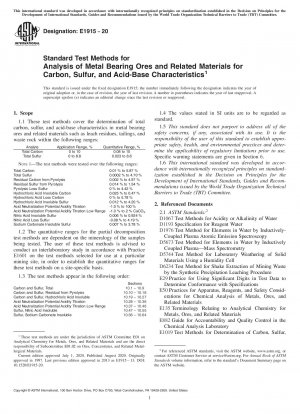ASTM E1915-20
Standard Test Methods for Analysis of Metal Bearing Ores and Related Materials for Carbon, Sulfur, and Acid-Base Characteristics
- Standard No.
- ASTM E1915-20
- Release Date
- 2020
- Published By
- American Society for Testing and Materials (ASTM)
- Latest
- ASTM E1915-20
- Scope
- 1.1 These test methods cover the determination of total carbon, sulfur, and acid-base characteristics in metal bearing ores and related materials such as leach residues, tailings, and waste rock within the following ranges: Analyte Application Range, % Quantitative Range, % Total Carbon 0 to 10 0.08 to 10 Total Sulfur 0 to 8.8 0.023 to 8.8 NOTE 1—The test methods were tested over the following ranges: Total Carbon 0.01 % to 5.87 % Total Sulfur 0.0002 % to 4.70 % Residual Carbon from Pyrolysis 0.002 % to 4.97 % Residual Sulfur from Pyrolysis 0.014 % to 1.54 % Pyrolysis Loss Sulfur 0 % to 4.42 % Hydrochloric Acid Insoluble Carbon 0.025 % to 0.47 % Hydrochloric Acid Loss Carbon 0 % to 5.78 % Hydrochloric Acid Insoluble Sulfur 0.012 % to 4.20 % Acid Neutralization Potential Acidity Titration -1.0 % to 100 % Acid Neutralization Potential Acidity Titration Low Range -1.0 % to 2 % CaCO3 Nitric Acid Insoluble Sulfur 0.006 % to 0.924 % Nitric Acid Loss Sulfur -0.08 % to 4.19 % Sodium Carbonate Insoluble Sulfur 0.007 % to 3.78 % 1.2 The quantitative ranges for the partial decomposition test methods are dependent on the mineralogy of the samples being tested. The user of these test methods is advised to conduct an interlaboratory study in accordance with Practice E1601 on the test methods selected for use at a particular mining site, in order to establish the quantitative ranges for these test methods on a site-specific basis. 1.3 The test methods appear in the following order: Sections Carbon and Sulfur, Total 10.1 – 10.9 Carbon and Sulfur, Residual from Pyrolysis 10.10 – 10.18 Carbon and Sulfur, Hydrochloric Acid Insoluble 10.19 – 10.27 Acid Neutralization Potential Acidity Titration 10.28 – 10.36 Acid Neutralization Potential Acidity Titration Low Range 10.37 – 10.46 Sulfur, Nitric Acid Insoluble 10.47 – 10.55 Sulfur, Sodium Carbonate Insoluble 10.56 – 10.64 1.4 The values stated in SI units are to be regarded as standard. 1.5 This standard does not purport to address all of the safety concerns, if any, associated with its use. It is the responsibility of the user of this standard to establish appropriate safety, health, and environmental practices and determine the applicability of regulatory limitations prior to use. Specific warning statements are given in Section 6. 1.6 This international standard was developed in accordance with internationally recognized principles on standardization established in the Decision on Principles for the Development of International Standards, Guides and Recommendations issued by the World Trade Organization Technical Barriers to Trade (TBT) Committee.
ASTM E1915-20 Referenced Document
- ASTM D1067 Standard Test Methods for Acidity or Alkalinity of Water
- ASTM D1193 Standard Specification for Reagent Water
- ASTM D1976 Standard Test Method for Elements in Water by Inductively-Coupled Argon Plasma Atomic Emission Spectroscopy
- ASTM D5673 Standard Test Method for Elements in Water by Inductively Coupled Plasma8212;Mass Spectrometry
- ASTM D5744 Standard Test Method for Accelerated Weathering of Solid Materials Using a Modified Humidity Cell
- ASTM D6234 Standard Test Method for Shake Extraction of Mining Waste by the Synthetic Precipitation Leaching Procedure
- ASTM E1019 Standard Test Methods for Determination of Carbon, Sulfur, Nitrogen, and Oxygen in Steel and in Iron, Nickel, and Cobalt Alloys*, 2024-04-21 Update
- ASTM E135 Standard Terminology Relating to Analytical Chemistry for Metals, Ores, and Related Materials
- ASTM E1601 Standard Practice for Conducting an Interlaboratory Study to Evaluate the Performance of an Analytical Method
- ASTM E1950 Standard Practice for Reporting Results from Methods of Chemical Analysis
- ASTM E2242 Standard Test Method for Column Percolation Extraction of Mine Rock by the Meteoric Water Mobility Procedure*, 2021-10-01 Update
- ASTM E29 Standard Practice for Using Significant Digits in Test Data to Determine Conformance with Specifications
- ASTM E50 Standard Practice for Apparatus, Reagents, and safety Precautions for Chemical Analysis of Metals
- ASTM E882 Standard Guide for Accountability and Quality Control in the Chemical Analysis Laboratory
ASTM E1915-20 history
- 2020 ASTM E1915-20 Standard Test Methods for Analysis of Metal Bearing Ores and Related Materials for Carbon, Sulfur, and Acid-Base Characteristics
- 2013 ASTM E1915-13 Standard Test Methods for Analysis of Metal Bearing Ores and Related Materials for Carbon, Sulfur, and Acid-Base Characteristics
- 2011 ASTM E1915-11 Standard Test Methods for Analysis of Metal Bearing Ores and Related Materials for Carbon, Sulfur, and Acid-Base Characteristics
- 2009 ASTM E1915-09 Standard Test Methods for Analysis of Metal Bearing Ores and Related Materials for Carbon, Sulfur, and Acid-Base Characteristics
- 2007 ASTM E1915-07a Standard Test Methods for Analysis of Metal Bearing Ores and Related Materials by Combustion Infrared-Absorption Spectrometry
- 2007 ASTM E1915-07 Standard Test Methods for Analysis of Metal Bearing Ores and Related Materials by Combustion Infrared-Absorption Spectrometry
- 2005 ASTM E1915-05 Standard Test Methods for Analysis of Metal Bearing Ores and Related Materials by Combustion Infrared Absorption Spectrometry
- 2001 ASTM E1915-01 Standard Test Methods for Analysis of Metal Bearing Ores and Related Materials by Combustion Infrared Absorption Spectrometry
- 1999 ASTM E1915-99 Standard Test Method for Analysis of Metal Bearing Ores and Related Materials by Combustion Infrared Absorption Spectrometry
